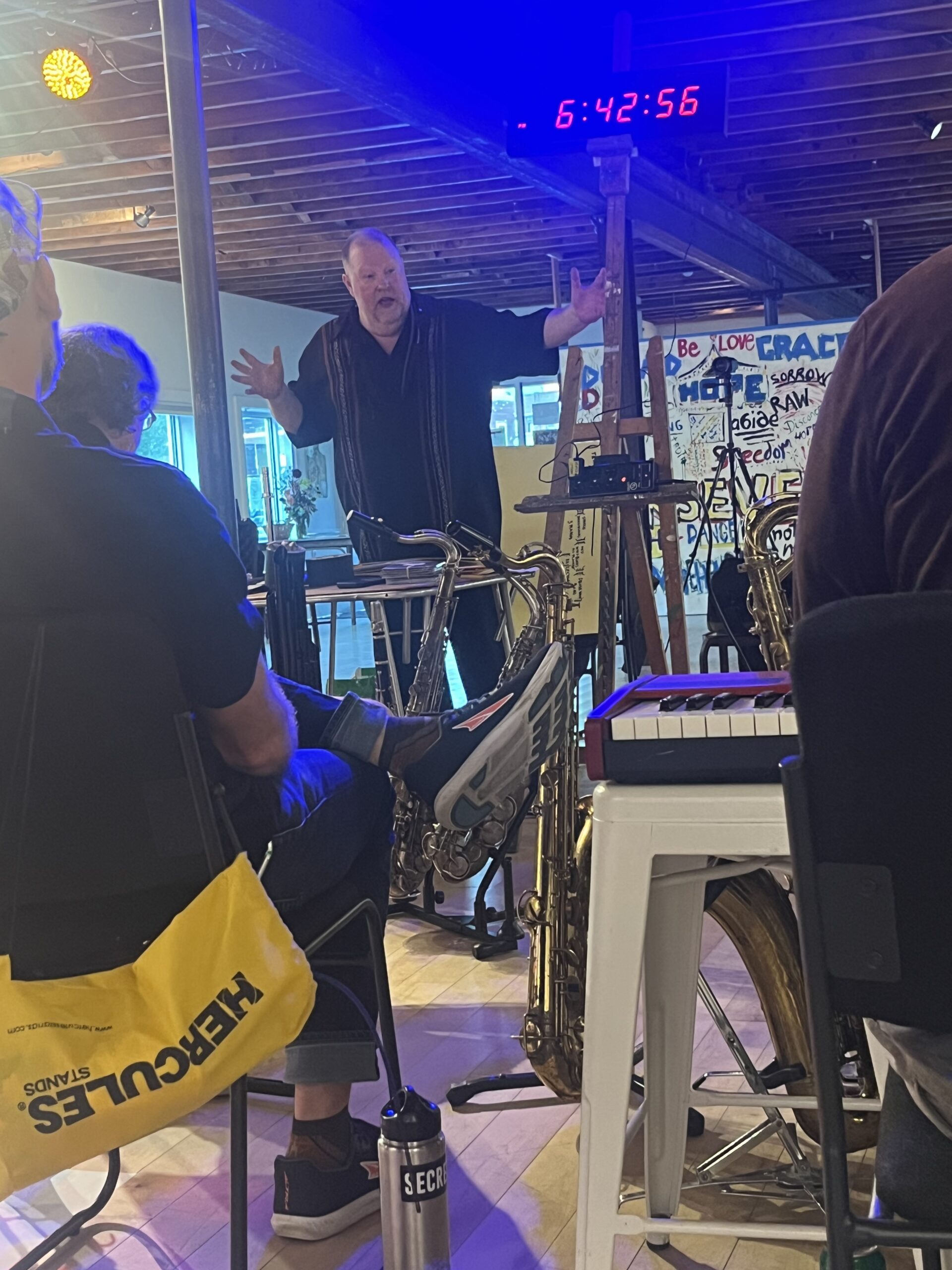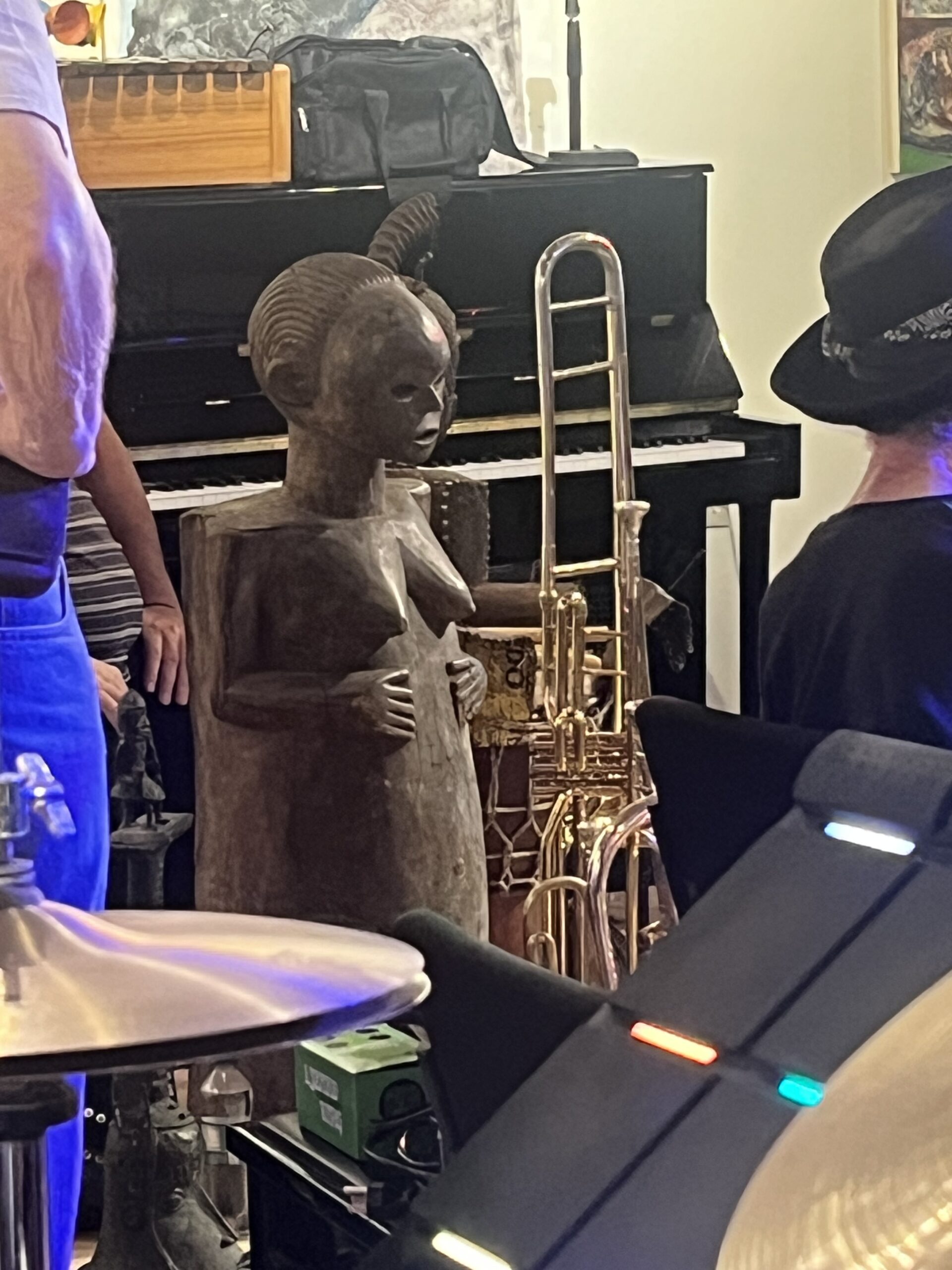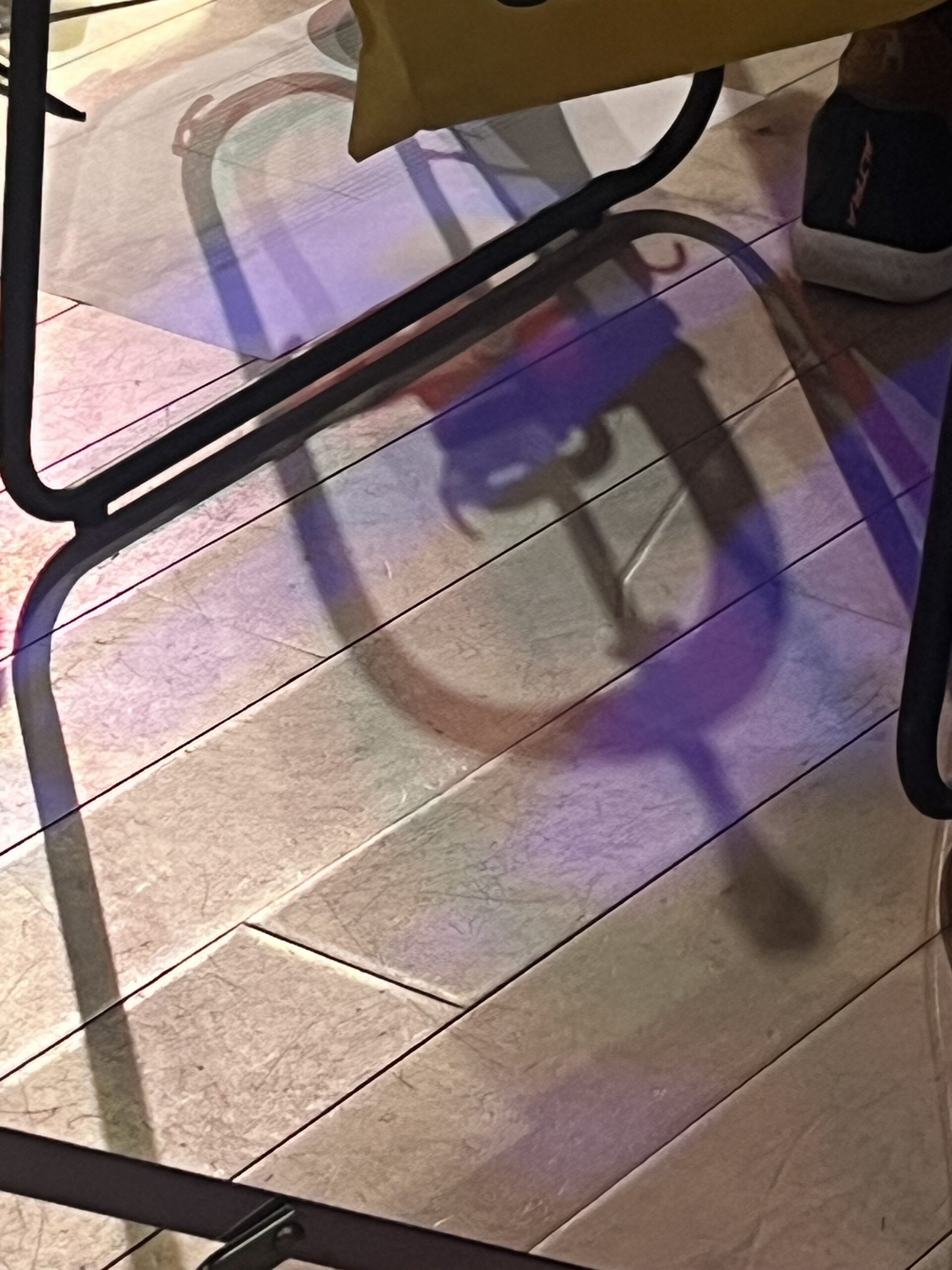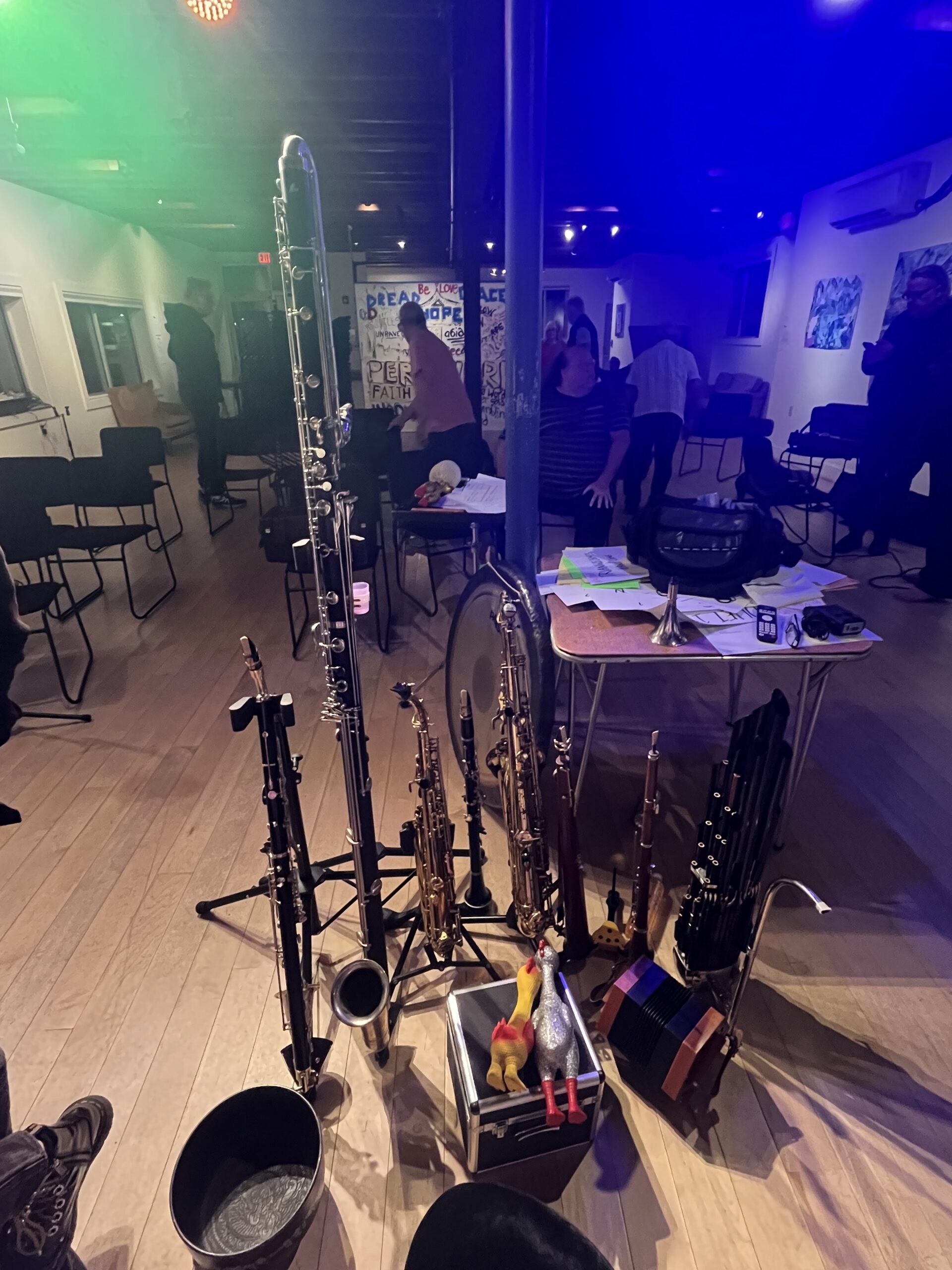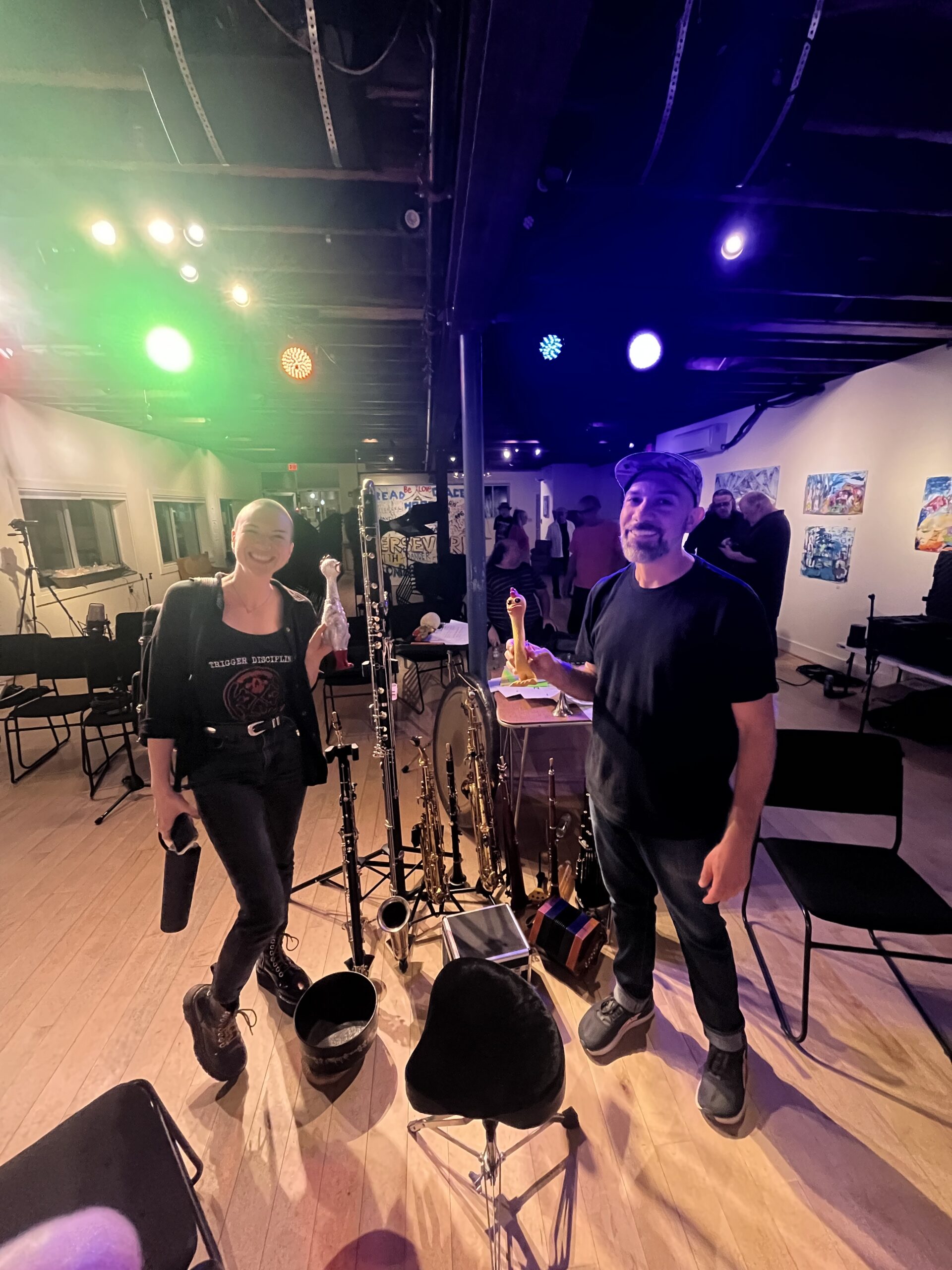Turbulence Orchestra & Sub-Units
The Storms of Jupiter
Excerpt From Liner Notes by PEK
“… Part II of the concert combines all 30 of the performers into the Orchestra, performing a continuous one-hour improvisation for Disc 2 of the CD package. The ensemble is bigger than the maximum numbers of players on Evil Clown Headquarters Livestreams and the largest orchestra ensemble yet to perform as either LOFO or TO&SU. As with all the Evil Clown projects, each time we do a performance we address a particular aesthetic problem and that sessions solutions inform the solutions of later sessions. Two TO&SU shows back, for Tempestuous Hubbub, I elected to focus my full attention on conducting the Orchestra Set instead of attempting to both conduct and perform on my instruments. For Crescendo of the Tempest, I addressed some technical issues – like improving the legibility of the signs I use to trigger events in the Orchestra – and, also extending the number and variety of the signs and the directions they give. The Storms of Jupiter extended those developments and included a more detailed planned opening sequence for roughly the first five minutes..…”
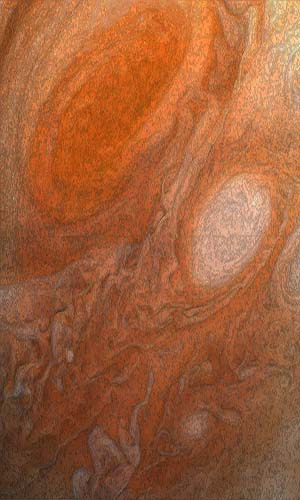
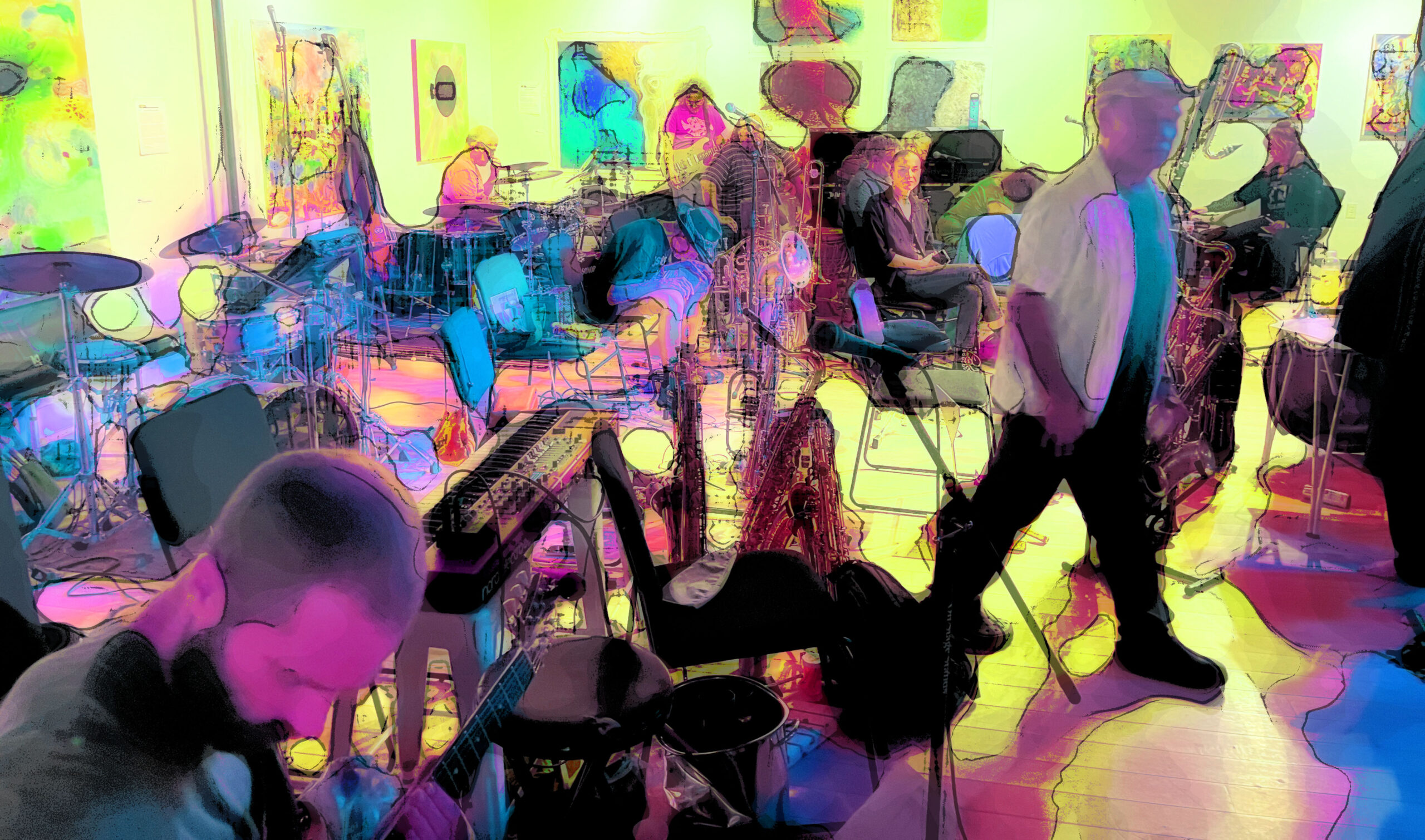
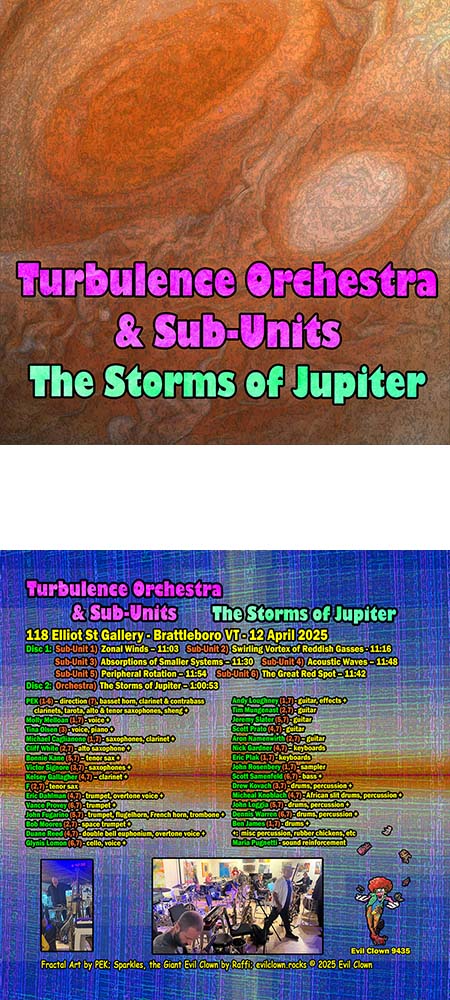
Turbulence Orchestra & Sub-Units
118 Elliot St Gallery, Brattleboro VT
23 August 2025
Disc 1:
Sub-Unit 1) Zonal Winds – 11:03
Sub-Unit 2) Swirling Vortex of Reddish Gasses – 11:16
Sub-Unit 3) Absorptions of Smaller Systems – 11:30
Sub-Unit 4) Acoustic Waves – 11:48
Sub-Unit 5) Peripheral Rotation – 11:54
Sub-Unit 6) The Great Red Spot – 11:42
Disc 2:
Orchestra 7) The Storms of Jupiter – 1:00:53
PEK (1-6) – direction (7), basset horn, clarinet & contrabass clarinets, tarota, alto & tenor saxophones, sheng +
Molly Melloan (1,7) – voice +
Tina Olsen (3) – voice, piano +
Michael Caglianone (1,7) – saxophones, clarinet +
Cliff White (2.7) – alto saxophone +
Bonnie Kane (5,7) – tenor sax +
Victor Signore (3.7) – saxophones +
Kelsey Gallagher (4,7) – clarinet +
F (2,6) – tenor sax +
Eric Dahlman (4,7) – trumpet, overtone voice +
Vance Provey (6,7) – trumpet +
John Fugarino (5,7) – trumpet, flugelhorn, French horn, trombone +
Bob Moores (2,7) – space trumpet +
Duane Reed (4,7) – double bell euphonium, overtone voice +
Glynis Lomon (6,7) – cello, voice +
Andy Loughney (1,7) – guitar, effects +
Tim Mungenast (2,7) – guitar +
Jeremy Slater (5,7) – guitar +
Scott Prato (4,7) – guitar +
Aron Namenwirth (2,7) – guitar +
Nick Gardner (4,7) – keyboards +
Eric Plaks (1,7) – keyboards +
Jon Rosenberg (1,7) – sampler +
Scott Samenfeld (6,7) – bass +
Drew Kovach (3,7) – drums, percussion +
Michael Knoblach (4,7) – African slit drums, percussion +
John Loggia (5,7) – drums, percussion +
Dennis Warren (6,7) – drums, percussion +
Ben James (1,7) – drums, percussion +
+: misc percussion, rubber chickens, etc
Maria Pugnetti (1-7) – Sound Reinforcement
Bandcamp | YouTube 1 | YouTube 2 | YouTube 3 | YouTube 4 | YouTube 5 | YouTube 6 | YouTube 7 | YouTube Shorties | Soundcloud
Full Set Videos
Video Shorties
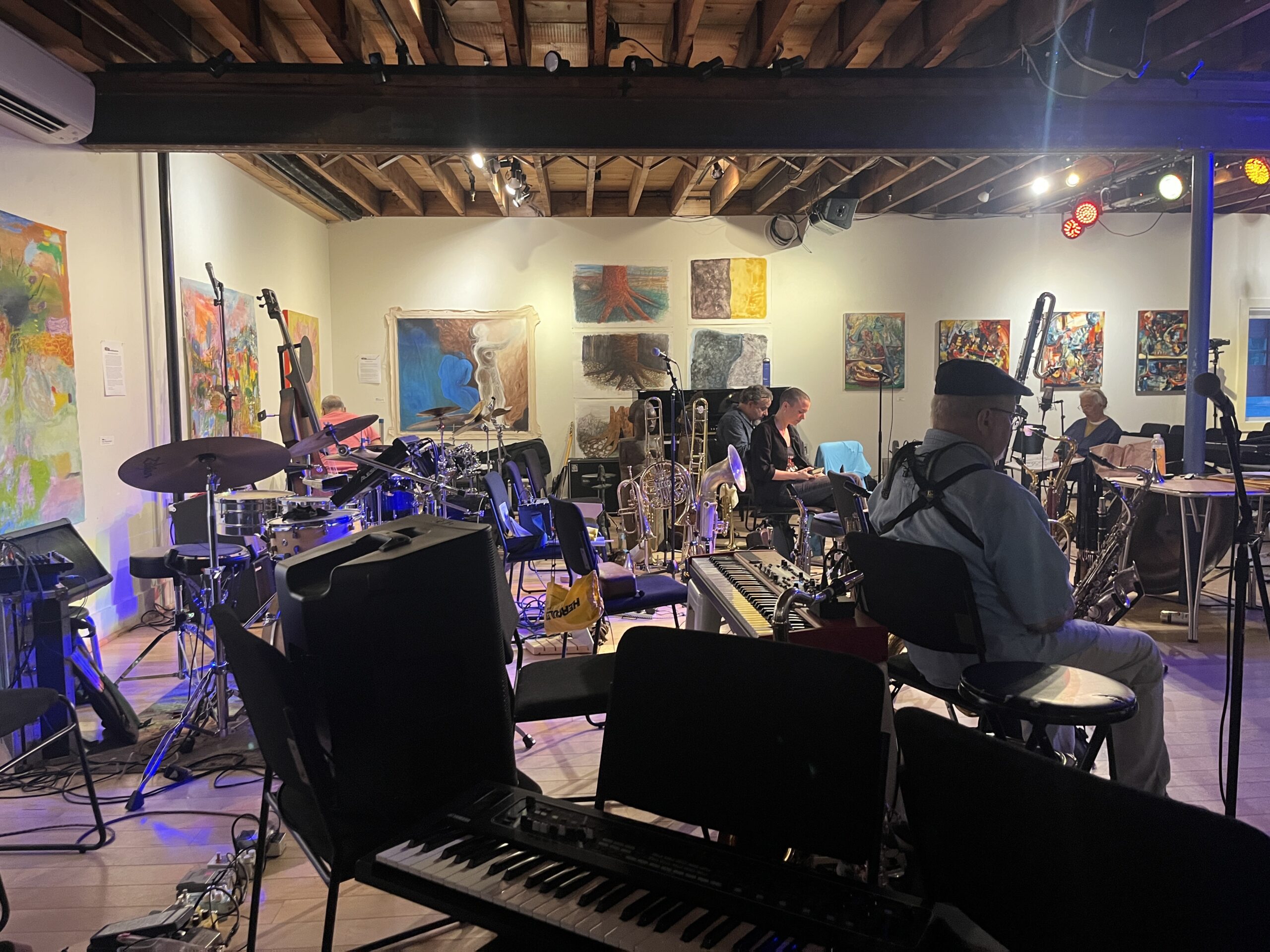

Liner Notes by PEK
I formed Turbulence in 2015 as I started to assemble players for the Leap of Faith Orchestra. Turbulence, the extended horn section for the Orchestra (along with guests on other instruments), also records and performs as an independent unit. As if this writing, in 2025, we have recorded over 60 albums on Evil Clown with greatly varied ensembles. All the smaller Evil Clown bands are really more about a general approach, rather than a specific set of musicians. A session gets credited to Turbulence when it is mostly horn players and the only musician on all of them is me. The sessions range from an early duet with Steve Norton and me (Vortex Generation Mechanisms) to a 5-horn band with bass and two percussionists (Encryption Schemes) to four albums by the side project Turbulence Doom Choir which feature myself, multiple tubas, percussion, electronics, and signal processing and many other configurations, to the large orchestra project Turbulence Orchestra & Sub-Units.
For the last several years, Bonnie Kane (tenor sax, flute, electronics) and John Loggia (drums), who have a long running improvisation duet, have been participating in Evil Clown sessions with Turbulence and Leap of Faith. Bonnie lives in Holyoake Ma and John lives in Brattleboro VT where he owns and operates a wonderful performance space at the 118 Elliot St Gallery. Bonnie runs a performance series in Holyoake and John is a central figure in the Brattleboro scene. John and I decided that we would do a Turbulence Orchestra performance at 118 Elliot where we would bring regulars from the Evil Clown Headquarters Turbulence sets in Waltham and add other musicians from the Western Mass and Vermont scenes. I really like this dynamic of multiple groups of familiar players performing with each other so that well established combinations and new combinations of players are interacting in the improvisation.
Turbulence Orchestra Livestreams (https://evilclown.rocks/turb-orchestra/) from Evil Clown Headquarters typically have an ensemble size of 8 to 12. For an ensemble of this size, I establish a rule that each performer should lay out for roughly a third of the total duration. Combined with the players each performing on multiple instruments, the resulting broad palate and shrinking and growing of the number of simultaneous players, creates a sequence of sonorities which run through the duration and tell a story. Generally, in improvisation, this transformation is necessary to establish form, which in more conventional music is determined by key, harmonic rhythm, rhythmic structure, modulations, tempo changes and other devices of traditional Western Music.
When the ensemble size grows much larger, I have used graphic scores to preplan these transformations without specifying specific pitches or rhythms. Six of these scores were performed by the Leap of Faith Orchestra with ensemble size as large as 25 in the several years prior to the pandemic (https://evilclown.rocks/lofo-graphic-scores/) (https://evilclown.rocks/lofogsp-essay/). I love this approach, but it is a tremendous amount of work – both to prepare the scores (which takes as much as 6 months) and to mount the performance (which requires a large Uhaul truck to move equipment). I have shifted to Livestream performances from the YouTube studio at ECH as the principal presentation method for the enterprise and am mounting only a few live performances a year instead of the roughly 20 live shows typical pre-pandemic.
We have now performed 4 TO&SU shows at Elliot St Gallery, and many of the players have been on all of them. Each time though, the ensemble has gotten a little larger as other players hear about the event and would like to participate. This time the show was part of a month long NU MU festival in Brattleboro featuring new music from many genres. John had several performances each weekend for the entire month of August and consequently some players joined our performance that were in town for other performances. In fact, we had musicians from 6 states! Massachusetts, Vermont, Maine, Connecticut, New York and New Hampshire.
This fifth performance of the Turbulence Orchestra & Sub-Units, The Storms of Jupiter, is modelled after 13 Leap of Faith Orchestra and Sub-Units performances (https://evilclown.rocks/lofo-sub-units/) which occurred during the same period at the now defunct performance space Third Life Studios in Somerville MA. We also performed once early in the Contemporary Period as TO&SU at the LilyPad in Cambridge. We present 6 Sub-Units comprised of a sixth of the total orchestra, each performing an 11-minute improvisation as part I of the concert. I selected the Sub-Units to combine some players from each of the scenes so that the familiar/new interaction dynamic would play out in the small group settings as well as the full orchestra setting. These 6 shorter pieces are Disc 1 of the CD package.
Part II of the concert combines all 30 of the performers into the Orchestra, performing a continuous one-hour improvisation for Disc 2 of the CD package. The ensemble is bigger than the maximum numbers of players on Evil Clown Headquarters Livestreams and the largest orchestra ensemble yet to perform as either LOFO or TO&SU. As with all the Evil Clown projects, each time we do a performance we address a particular aesthetic problem and that sessions solutions inform the solutions of later sessions. Two TO&SU shows back, for Tempestuous Hubbub, I elected to focus my full attention on conducting the Orchestra Set instead of attempting to both conduct and perform on my instruments. For Crescendo of the Tempest, I addressed some technical issues – like improving the legibility of the signs I use to trigger events in the Orchestra – and, also extending the number and variety of the signs and the directions they give. The Storms of Jupiter extended those developments and included a more detailed planned opening sequence for roughly the first five minutes.
The signs fall into several categories:
- Window Sign – Window Signs indicated groups of performers and now include the Sub Unit Names, general instrument groupings like Drums, Reeds, Brass, Overtone Voices, etc, and two different kinds of duet groupings – two players from different sonority sets (like a horn and drummer) and two players from the same sonority set (like two guitars)
- Connector Signs – Connector Signs include a Plus sign (+) and a Minus sign (-).
- Action Frame Signs – Action Group signs describe coordinated events which are triggered by conducted downbeats. An example is an alternation between Frenzy and Thin…
When I display a Window Sign the member of the Group on the sign have 30 seconds to make an entrance while the players currently playing have the same 30 seconds to make an exit. If I display a Window Sign and the Plus Sign at the same time, then the players that are already playing continue, and the players in the group on the sign add themselves in the 30 second window. If I display the Minus Sign with a Window Sign, then the group on the window sign has 30 seconds to exit.
The combination of the Plus and Minus signs with the much larger selection of small group assignments on Window Signs allowed me to keep the overall average unit size smaller than the earlier performances by this ensemble. I could easily gradually grow and shrink the ensemble size and resulting sound density. This breakthrough in the preperformance planning will be repeated and elaborated in the future performances of the TO&SU… Stay Tuned!!!
John and I spoke after the performance, and the plan is to repeat this Turbulence Orchestra and Sub-Units performance twice per year in the Spring and the Fall when there are no Winter weather travel issues and no Summer heat issues. The next one is likely to be in April 2026 – We’ll fix a date in the calendar in the coming months.
Anyway, I like this set and I bet you will too…
PEK – 9/2/2025
Photos
